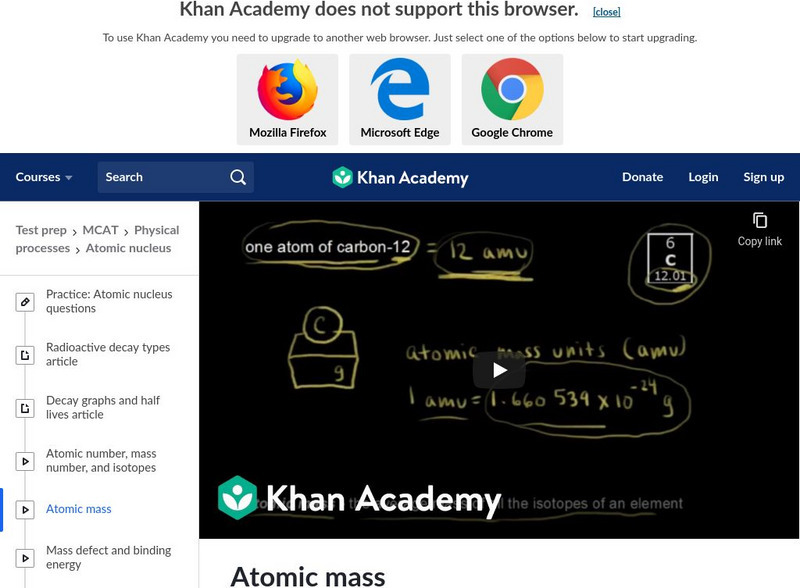Hi, what do you want to do?
Fuse School
Relative Atomic Mass
Investigate how to calculate the relative atomic mass of elements. The video instructor explains how isotopes occur naturally for many elements. She then describes the process of calculating the relative atomic mass of an element using...
Fuse School
In Depth: Atomic Mass Units
The facts are in the numbers! Using atomic mass units, a video lesson explains the carbon atom as the reference mass. Building from that idea, the narrator describes the relative isotopic mass.
Fuse School
How the Elements are Laid Out in the Periodic Table
When scientists confirm new elements, do these elements always fit in on the periodic table where scientists expect? The second video in a series of 15 discusses how the elements are organized on the periodic table. The resource...
SciShow
Mendeleev's Periodic Table
Scientists are working on creating and verifying element 120 which would change the appearance of the periodic table. A short video, one in a series of 48, which explores Mendeleev's Periodic Table. The narrator shows how Mendeleev...
Fuse School
Calculating Percentage Mass
More than half of your body is made of water, but what percentage of you is made up of hydrogen? This video explains how to solve for percentage mass. It uses water as one example of solving for both hydrogen and oxygen.
Fuse School
Theoretical Yield and Losses
Theory is when you know everything, but nothing works right. Video focuses on how to find theoretical yield and why the theory doesn't work in reality. It includes a practice problem for finding the theoretical yield and concludes with...
Fuse School
What is a Weighted Average?
Have you ever wondered why the atomic mass listed on the periodic table isn't a whole number? This video explains how weighted averages are calculated and relates the average to the relative atomic mass. Viewers are then given an element...
DoodleScience
Atomic Structure
The Rutheford plum pudding model of an atom, as well as the nuclear model, are the subject of a video that also includes an explanation of protons, neutrons, electrons, nucleus, atomic mass, atomic charge, and ions.
Crash Course
The Nucleus
Einstein didn't just discover relativity, he proved the existence of atoms in 1905 — more than 110 years ago. Discover how he did it and begin learning about basic chemistry: parts of an atom, atomic mass, atomic number, and how to read...
Crash Course
Stoichiometry: Chemistry for Massive Creatures
Moles exist in chemistry? These are not animals that live underground and dig through your gardens — they are quantities of elements. Learn about moles and how they help chemists determine amounts of substances (from atomic mass to grams).
Ricochet Science
Understanding Atomic Number and Atomic Mass
The amount of information you can learn about an element from the periodic table is amazing! Young scientists learn how to interpret the atomic number and atomic mass. Using a carbon atom as an example, the instructor describes the...
Berkeley University of California
Relative Atomic and Molecular Mass
Did you know that body armor actually contains uranium? Learn about how isotopes of the same element have different masses and unique physical properties.
Berkeley University of California
Atomic Structure
How are atoms structured? Viewers of the video first learn about atoms and atomic structure, including the nucleus and electron shells. The video then describes how atomic numbers and atomic masses are expressed on atomic symbols. You'll...
Berkeley University of California
Relative and Atomic Molecular Mass
Relative molecular masses sure have a lot of decimal places! Watch the video to learn how the number of particles in one mole of carbon-12 determines relative atomic and molecular masses. Viewers also learn how to calculate the...
Get Chemistry Help
Chemistry Lesson: Balancing Chemical Equations
An informative video segment describes how to balance chemical equations. It ensures pupils will obey the laws of conservation of mass and shares tips to assist young chemists who may need additional help to ensure a more simplistic...
Get Chemistry Help
Chemistry Lesson: Mole Ratio from Chemical Formulas
Need an exciting way to teach mole ratios? This short video segment details a step-by-step method to determine the mole ratio of chemical compounds and relates these ratios to molar mass. The resource may be used to enhance your...
Get Chemistry Help
Chemistry Lesson: Molar Mass
Enhance your current chemistry curriculum with a short video that demonstrates how to calculate the molar mass of a compound. There is also instruction for conversion between moles and mass, outlined in simple steps and demonstrated in a...
Curated OER
Understanding The Periodic Table
This is a really great teaching tool. Use to explain the parts, nature, and how to use the periodic table. This clip uses no narration, just text and images which makes it perfect for stopping to engage in discussion. Download and save...
Curated OER
Electricity and Matter Part 4 - Atoms and Elements
Consisting entirely of photos and simple graphics, this fundamental video is an informative presentation. Topics include elements, molecules, chemical bonds, atomic mass, isotopes, and ionization. Because it covers a wide range, it would...
Khan Academy
Khan Academy: Biology: Chemistry of Life: Introduction to the Atom
A video investigating the makeup of an atom. Learn that atoms are composed of protons, neutrons, and electrons. Understand that protons and neutrons determine the mass of an atom. Also, the atomic number gives you the number of protons...
Khan Academy
Khan Academy: Worked Example: Atomic Weight Calculation
A video showing an example of how to use the atomic mass and percent abundance of the carbon isotopes to calculate atomic weight. [4:26]
Khan Academy
Khan Academy: The Mole and Avogadro's Number
One mole of a substance is equal to 6.022- 10^23 units of that substance (such as atoms, molecules, or ions). The number 6.022- 10^23 is known as Avogadro's number or Avogadro's constant. The mole can be used to convert between atomic...
Khan Academy
Khan Academy: Test Prep: Mcat: Physical Processes: Atomic Nucleus: Atomic Mass
Explains how we measure the mass of an atom. [8:33]
Next Vista for Learning
Next Vista for Learning: Bohr Model of the Atom
This video takes you inside the atom to learn about the subatomic particles present and their location. Also learn about what the atomic number and mass number tell you about the number of protons, neutrons, and electrons. [1:35]




























